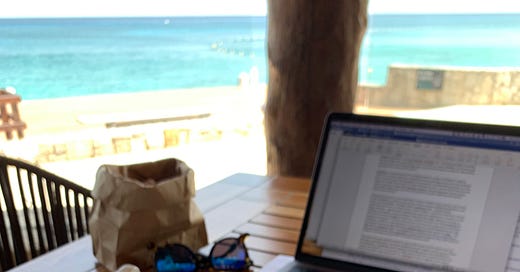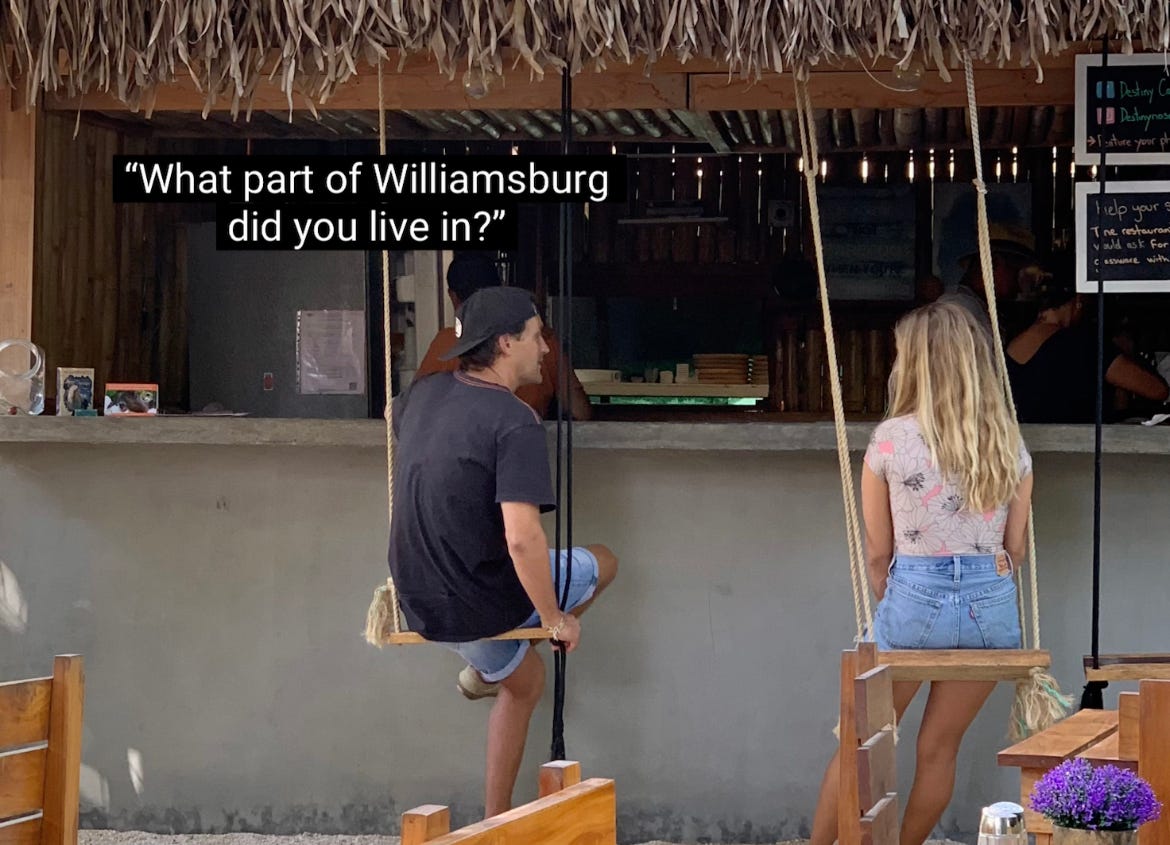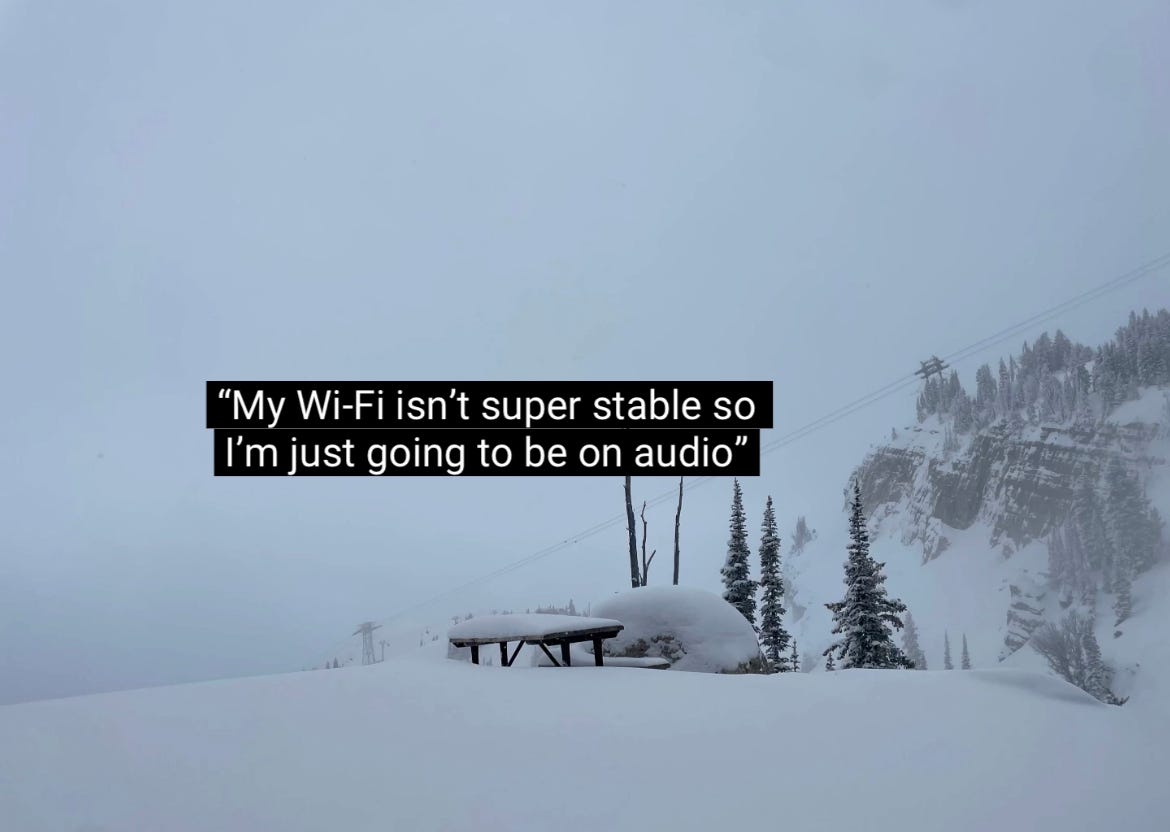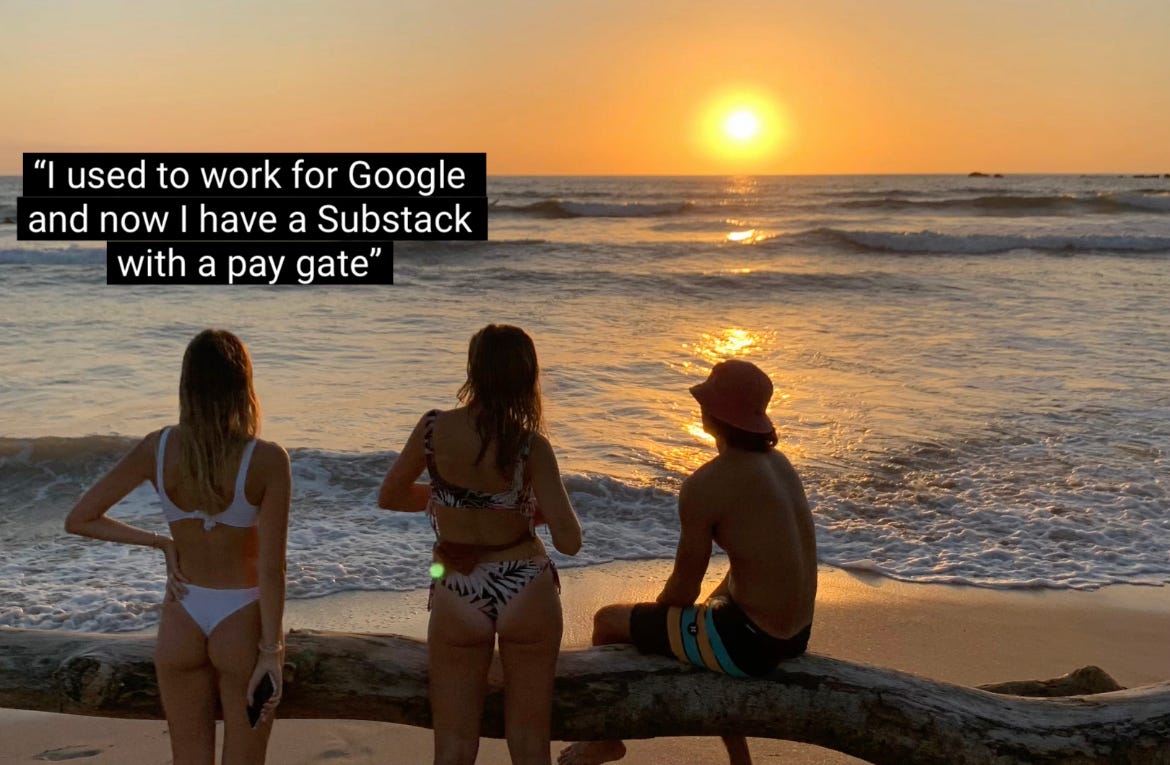Digital Nomads: Colonialism 2.0
The untold impact of Millennials who flit about the world with their laptops "working remotely"
37,000 feet in the air on a one-way flight from NYC to Jackson, Wyoming for an indeterminate period seems like the right time to take a break from self-awareness and pillory digital nomads. The week that never was, never is, nor ever shall be (Dec 26 – January 1) is the peak winter migration time for younger adults who can work remotely and have no trace of accountability to anything other than their Athletic Greens subscription. You may be thinking, “I’ve heard enough about digital nomads – tell me about a new topic that will irritate me.” It’s true that digital nomads and their -isms have been abundantly documented, but like the virus that caused them, the long-term effects of digital nomads have been unknown. Until now.
Let’s first be sure we share a definition of “digital nomad.”
Digital nomads are younger adults who can work exclusively through their Apple products, an Internet connection and the delusion of their own grandeur. They may at one point have attended an office before buying a flat brimmed hat, sometimes even a really serious office – like an investment bank or their family’s family office – but have now reached a point in their lives where they can either Zoom it in or milk their trust fund, which activated on their 30th birthday but definitely should have remained inaccessible until their 60th.
Digital nomads have a wide array of rewarding careers. Many digital nomads are focused on writing about digital nomadism-ing. Others run niche products companies that cater to other digital nomads, and some have niche services companies that provide coaching and wellness advisory to other digital nomads. Most digital nomads, however, just bring their laptops to the most expensive coffee shop in whatever beach or mountain town where the vibe currents have taken them, open FaceTime, and study their own face to give them the appearance of industry, waiting until they spot another younger, attractive person wearing a flat brimmed hat.
Conversation at coffee shops between two digital nomads begins with a self-centered question like, “are you from New York, too?” Particularly narcissistic digital nomads will bypass this perfunctory yes-no question and go straight for the hipster jugular: “what part of Williamsburg did you live in?” Conversation from here will vary based on gender, their level of attractiveness, and the caliber of adornment on their flat brimmed hats. For example, an average looking male digital nomad talking with a female digital nomad will get much further if he’s wearing a flat brimmed hat with a match stick in the trim, and the more attractive a female digital nomad is, the more likely it is that she will be invited to a long-table dinner that night at the temporary residence of a male digital nomad. Two male digital nomads do not engage in conversation under any circumstances, and two female digital nomads bypass conversation and go straight into an eye gazing ceremony.
Now, let’s review the effects of digital nomads.
Economists at the World Bank have spent the past eighteen months studying the economic impact of digital nomads, and the report they released via Instagram stories this week has revealed nothing short of a global disaster. Despite the fact that digital nomads spend an average of only seven weeks, three days and nine hours per year in a given place, their presence drives the cost of living up by a vibe-harshing 170% and erases the best of every local culture.
“Digital nomads change the dynamics of usually very delicate economies,” said Joachim Wagenbauer, PhD and World Bank Senior Economist. “The first few discover a location known for its natural beauty or authentic culture, and they take over all of the available short-term housing. They post their location on Instagram, and this draws even more digital nomads from the more expensive parts of Williamsburg, Greenpoint and Bushwick, which creates a housing shortage. They loudly comment in coffee shops about how inexpensive the cappuccinos are, which causes the proprietors to raise prices, which compels other proprietors to raise prices on all manner of goods and services. This hipster butterfly effect – or HBE – forces locals to turn their primary residences into Airbnbs and move further away from the culture they created, which erodes the appeal of the place until all that is left are digital nomads and disgruntled baristas.”
Dr. Wagenbauer shrugs and takes a long hit from his vape pen.
“And what’s really even more tragic” – he coughs – “is that after seven or eight weeks these young people pack their Away, Tumi and Rimowa bags and go someplace else and do it all over again. They leave behind a town stripped of its original appeal and in total economic ruin,” he says through a cloud of purple vapor, shaking his head. “Digital nomads are like locusts. Locusts who surf, ski and drink artisanal coffee.”
Dr. Wagenbauer and his colleagues identify in their report the top 10 of what they call Digital Nomad Compromised Regions (DNCRs). Data sources used by the World Bank to identify these DNCRs include the average price of oat cappuccinos, sudden drops in Airbnb occupancy rates, and the number of new Uber drivers. Data feeds were obviously compiled only in ski resort towns, along stretches of ocean where the average temperature is consistently above 78 degrees, and in towns all over the world known for yoga.
The World Bank’s top 10 DNCRs, ranked in order of economic disruption:
10. Aspen
9. Anywhere within 46 minutes of Lake Tahoe (except for Reno)
8. Montana
7. Santa Barbara, CA
6. Jackson, WY ( ¯\_(ツ)_/¯ )
5. The Rocky Mountains
4. Rishikesh, India
3. CDMX (aka Mexico City)
2. Bali
1. Costa Rica (entire country)
You may be wondering why Tulum, the progenitor of DNCRs, was not listed. Tulum prior to 2020 was already on the precipice of sub-habitability, even for digital nomads who are only digital in the sense that they use their cell phones to summon DJs and drug dealers. Between March 2020 and February 2021, Tulum became what you see when you make the mistake of glancing down into the tank of port-a-potties at music festivals. Chiefly because everyone who was still going to Tulum after 2018 were entirely full of shit, the sewage systems crashed, and empty Liquid Death containers formed piles on the beaches where once there had been artful, anatomically correct sand mermaids shaped by extremely high hippies. Mother Nature herself said, “fuck that place,” and sent armadas of stinking seaweed to choke the shores and keep bathers covered in glitter and ketamine from further polluting her ocean, and today the only vague lifeforms are Sebastian Sas (owner of Hotel Nomade - sorry, Nômade), his drug dealers, and a DJ from New Jersey who has been passed out on the beach since New Years 2017.
How do locals feel about Digital Nomads?
Despite the challenge of finding people in these DNCRs who lived there before 2020, I did manage to speak with a local surf instructor in the diminutive, inaccessible and exorbitantly expensive Costa Rican town of Nosara. The son of a restauranteur and a real estate developer, Juan-Carlos “Ito” Morrero grew up surfing the perfect break at Playa Guiones and opened a surf school in 2009 at the age of 12. He lost his virginity a year later to what could be described as an primordial form of digital nomad, then known as the Traveling Yoga Instructor Recently Out of a Long-term Relationship with the Hedge Fund Manager She Thought She Was Going to Marry, Who Is Now On an Eat-Slay-F*ck Tour of Tropical Beach Towns. Let’s call them Yogis for short.
The Yogi taught Ito how to use social media, and he start promoting his surf school first on Facebook and then Instagram through selfie videos of him pensively watching the ocean at sunset. This drew a consistent supply of Yogis for him to “teach,” and he has seen first-hand how Nosara changed as the number of tourists, now called digital nomads, herded in from the more expensive parts of Williamsburg, Greenpoint and Bushwick.
“I love it,” Ito says with a grin. “My mother and I bought a bunch of a land in 2009, put some casitas and a teak deck on it, bought a StarLink and called it a yoga retreat. We’re sold out through 2025.”
Other locals haven’t benefited as much.
I spoke to Luisa Gutierrez, MD, the doctor who runs Nosara’s urgent care clinic, who mourned the erosion of the local community and the changes not only to the town but the entire country. “People don’t realize this, but Costa Rica has had to change the national language to English and the currency to the American dollar,” she told me. “It’s now federal law that all coffee shops have a La Marzocco espresso machine and carry three different brands of oat milk. We have some of the best, most natural dairy on the planet, and these people are asking for foamy carcinogens? Let them dig their own $8 grave,” she said.
Digital nomads have also had a significant effect on other foundational elements of daily life, including religion and healthcare.
“Costa Rica was predominantly Catholic, and now most of the churches have been converted to Airbnbs because rents are larger than tithes and offerings,” said Dr. Gutierrez. “People who now live in these churches say they’re Buddhist, but when I asked someone who came in to be treated for Chlamydia about the elephant necklace he was wearing, he said he got it at ritual where they burn men in the desert. That doesn’t sound very Buddhist to me.”
Dr. Gutierrez explained that the medical industry had changed in the past three years, with demand for certain medications and products rocking the country’s supply chain. Despite the fact that horses are only used for sunset beach rides by Instagram influencers, the need for ketamine has skyrocketed. Costa Rica was ironically once a premier destination for medical tourism, and now Costa Ricans must travel to neighboring countries just to buy Sesame Street themed band-aides.
“I think the days are numbered for our elected officials,” she added. Dr. Gutierrez told me that Americans had achieved the rank of mayor at coffee shops all over the country on a once defunct but quietly thriving Internet application called FourSquare. “If they are already the mayor of coffee shops, then what’s next? Will they overthrow the government?”
Worry not, Dr. Gutierrez, because digital nomads can’t commit to anything more than their daily oat cappuccino and their weekly 3-minute meditation on Calm.
What does a future with digital nomads look like?
2022 was a significant year for digital nomads, in that one of the last great symbols of classic colonialism passed away. Without her long pastel shadow, digital nomads have been left to ponder what colonialism 2.0 looks like. Is a digital nomad still nomadic if they stay in a high-vibes destination for more than seven weeks? How much of their clothing should they bring with them, and how much should they have custom made by local tailors? How many regional Burns are too many? What milk will they impose on haggard baristas once oat milk loses the last of its waning cachet?
Only time will reveal the answers to these questions, but if there’s one thing that digital nomads have a crippling abundance of, it’s time
.










Love this!
I’m on a flight to #1 Costa Rica right now! (But you probably already know that, bc we Nomads always post our next destination on Insta stories). 🏝️
I packed 2 flat brim hats… both with matchstick adornment. 🎩
Sending love from my Apple device! 💜